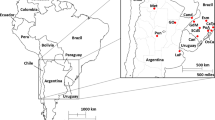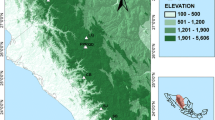Abstract
Genetic variations in Anastatica hierochuntica populations in Libya, Egypt and Saudi Arabia were investigated among and within multigenerational population cohort’s levels. Considering population demography within-population cohorts, the greatest number of individuals was recruited in the mid-season cohort that received intermediate amount of rainfall compared to the early-season and the late-season population cohorts. Individuals of A. hierochuntica belonging to the same population cohort showed that spatial pattern varied between clumped and random distribution, with minimum separation distance not exceeding 10 cm. The spatial pattern within-population cohorts showed decreased overdispersion from the early-season toward the late-season individuals. Considering the spatial relationships between the within-population cohorts, the spatial relationships between early-season and mid-season, and mid-season and late-season cohorts varied between segregation and random distributions. The gene diversity and the number of recruited individuals were found to be not correlated with the amount of rainfall in the study regions. Nei’s genetic identity and distance varied among sites and population cohort groups. The overall genetic diversity was lower in the mid-season cohort group than in the early- and late-season cohorts. The variations of genetic characters and spatial patterns among and within-population cohorts of A. hierochuntica are regulated by recruitment of individuals from persistent seed output produced from overlapping generations.







Similar content being viewed by others
References
Ackerly DD, Dudley SA, Sultan SE, Schmitt J, Coleman JS, Linder CR, Sandquist DR, Geber MA, Evans AS, Dawson TE, Lechowicz MJ (2000) The evolution of plant ecophysiological traits: recent advances and future directions. Bioscience 50:979–995
Ali IB, Guetat A, Boussaid M (2012) Genetic diversity, population structure and relationship of Tunisian Thymus algeriensis Boiss. et Reut. and Thymus capitatus Hoff. et Link. assessed by isozymes. Ind Crop Prod 36:149–163
Ayre DJ, Ottewell KM, Krauss SL, Whelan RJ (2009) Genetic structure of seedling cohorts following repeated wildfires in the fire-sensitive shrub Persoonia mollis ssp. nectens. J Ecol 97:752–760
Barrett SCH, Kohn JR (1991) Genetics and evolutionary consequences of small population size in plants: implications for conservation. In: Falk DA, Holsinger KE (eds) Genetics and conservation of rare plants. Oxford University Press, New York, pp 3–30
Bessag JE (1977) Comments on ripley’s paper. J Royal Stat Soc B 39:193–195
Brinegar C (2009) Assessing evolution and biodiversity in plants at the molecular level. KUSET 5:149–159
Bullock JA, Moy IL (2004) Plants as seed traps: interspecific interference with dispersal. Acta Oecol 25:35–41
Caballero I, Olano JM, Luzuriaga AL, Escudero A (2005) Spatial coherence between seasonal seed banks in a semi-arid gypsum community: density changes but structure does not. Seed Sci Res 15:153–160
Cabin RJ, Marshall DL (2000) The demographic role of soil seed banks. I. Spatial and temporal comparisons of below- and above-ground populations of the desert mustard Lesquerella fendleri. J Ecol 88:283–292
Cabin RJ, Marshall DL, Randall DL, Mitchell J (2000) The demographic role of soil seed banks. II. Investigations of the fate of experimental seeds of the desert mustard Lesquerella fendleri. J Ecol 88:293–302
Chung MY, Epperson BK, Gi Chung M (2003) Genetic structure of age classes in Camellia japonica (Theaceae). Evolution 57:62–73
Cohen JI (2013) A phylogenetic analysis of morphological and molecular characters of Boraginaceae: evolutionary relationships, taxonomy, and patterns of character evolution. Cladistics (in press, published online)
Dick CW (2008) New interpretations of fine-scale spatial genetic structure. Mol Ecol 17:1873–1876
Eriksson O, Ehrlén J (1992) Seed and microsite limitation of recruitment in plant populations. Oecologia 91:360–364
Excoffier L, Laval G, Schneider S (1992) Arlequin ver. 3.0: an integrated software package for population genetics data analysis. Evol Bioinform 1:47–50
Friedman J, Stein Z (1980) The influence of seed dispersal mechanism on the dispersion of Anastatica hierochuntica (cruciferae) in the Negev desert. Isr J Ecol 68:43–50
Friedman J, Gunderman N, Ellis M (1978) Water response of the hygrochastic skeletons of the true rose of Jericho (Anastatica hierochuntica L.). Oecologia 32:289–301
Gutterman Y (1993) Seed germination in desert plants (adaptation of desert organisms). Springer, Germany, p 253
Gutterman Y, Shem-Tov S (1997) The efficiency of the strategy of mucilaginous seeds of some common annuals of the Negev adhering to the soil crust to delay collection by ants. Isr J Plant Sci 45:317–327
Haase P (1995) Spatial pattern analysis in ecology based on Ripley’s K-function: introduction and methods of edge correction. J Veg Sci 6:575–582 (note corrections to eq. 4 and 5 given in J Veg Sci 7: 304)
Haase P (2001) Can isotropy vs. anisotropy in the spatial association of plant species resolve physical vs. biotic facilitation? J Veg Sci 12:127–134
Haase P (2002) Spatial point pattern analysis (SPPA), computer program version 2.0
Hampe A (2004) Extensive hydrochory uncouples spatiotemporal patterns of seedfall and seedling recruitment in a ‘bird-dispersed’ riparian tree. J Ecol 92:797–807
Hamrick JL, Godt MJW (1996) Conservation genetics of endangered plant species. In: Avise JC, Hamrick JL (eds) Conservation genetics: case histories from nature. Chapman & Hall, London, pp 281–304
Hardesty BD, Dick CW, Kremer A, Hubbell S, Bermingham E (2005) Spatial genetic structure of Simarouba amara Aubl. (Simaroubaceae), a dioecious, animal-dispersed Neotropical tree, on Barro Colorado Island, Panama. Heredity 95:290–297
Hegazy AK (1990) Growth, phenology, competition and conservation of two desert hygrochastic annuals raised under different watering regimes. J Arid Environ 19:85–94
Hegazy AK (1999) Allelopathy in desert ecosystems: an overview, problems and prospects. In: Narwal SS (ed) Basic and applied aspects, vol 2., Allelopathy updateOxford and IBH Publishing Co. Pvt. Ltd, India
Hegazy AK, Kabiel HF (2007) Significance of microhabitat heterogeneity in the spatial pattern and size-class structure of Anastatica hierochuntica L. Acta Oecol 31:332–342
Hegazy AK, Kabiel HF (2010) Size-class structure and growth traits of Anastatica hierochuntica L. populations as rainfall indicators in arid lands. J Adv Res 1:331–340
Hegazy AK, Elfiky A, Kabiel HF (2005) Spatial pattern and mulching effect of Anastatica hierochuntica L. on structure and function of some desert plants. Proceeding of the 4th World Congress on Allelopathy, Charles Sturt University, Wagga Wagga, NSW, Australia, 21–26 August 2005, pp 57–63
Hegazy AK, Mansour KS, Abdel-Hady NF (1990) Allelopathic and autotoxic effects of Anastatica hierochuntica L. J Chem Ecol 16:2183–2193
Hegazy AK, Barakat HN, Kabiel HF (2006) Anatomical significance of the hygrochastic movement in Anastatica hierochuntica. Ann Bot 97:47–55
Hegazy AK, Kabiel HF, Alatar AA, Lovett-Doust J (2013) Dynamics and persistence of Anastatica hierochuntica populations under simulated rainfall treatments. Pol J Ecol 61:493–504
Jacquemyn H, Wiegand T, Vandepitte K, Brys R, Roldán-Ruiz I, Honnay O (2009) Multigenerational analysis of spatial structure in the terrestrial, food-deceptive orchid Orchis mascula. J Ecol 97:206–216
Matesanz S, Valladares F (2013) Ecological and evolutionary responses of Mediterranean plants to global change. Environ Exp Bot (in press, published online)
McCue KA, Holtsford TP (1998) Seed bank influences on genetic diversity in the rare annual clarkia springvillensis (Onagraceae). Am J Bot 85:30–36
Morris AB, Baucom RS, Cruzan MB (2002) Stratified analysis of the soil seed bank in the cedar glade endemic Astragalus bibullatus: evidence for historical changes in genetic structure. Am J Bot 89:29–36
Neel M (2008) Patch connectivity and genetic diversity conservation in the federally endangered and narrowly endemic plant species Astragalus albens (Fabaceae). Biol Conserv 141:938–955
Parker KC, Hamrick JL, Parker AJ, Nason JD (2001) Fine-scale genetic structure in Pinus clausa (Pinaceae) populations: effects of disturbance History. Heredity 87:99–113
Ripley BD (1976) The second-order analysis of stationary processes. J Appl Prob 13:255–266
Schmitt J, Dudley SA, Pigliucci M (1999) Manipulative approaches to testing adaptive plasticity: phytochrome-mediated shade avoidance responses in plants. Am Nat 154:S43–S54
Schupp EW (1988) Factors affecting post-dispersal seed survival in a tropical forest. Oecologia 76:525–530
Shikano T, Shimada Y, Herczeg G, Merilä J (2010) History vs. habitat type: explaining the genetic structure of European nine-spined stickleback (Pungitius pungitius) populations. Mol Ecol 19:1147–1161
Shimono A, Ueno S, Tsumura Y, Washitani I (2006) Spatial genetic structure links between soil seed banks and above-ground populations of Primula modesta in subalpine grassland. J Ecol 94:77–86
Upton G, Fingleton B (1985) Spatial data analysis by example. In: Point pattern and quantitative data, vol 1. John Wiley, New York
Van Oudtshoorn RK, Van Rooyen MW (1999) Dispersal biology of desert plants. Springer, Germany 241 pp
Vekemans X, Hardy OJ (2004) New insights from fine-scale spatial genetic structure analyses in plant populations. Mol Ecol 13:921–935
Yeh FC, Yang R-C, Boyle T, Ye Z-H, Mao JX (1999) POPGENE: the user-friendly shareware for population genetic analysis. Molecular Biology and Biotechnology Centre, University of Alberta, Canada
Acknowledgments
We thank the Deanship of Scientific Research, College of Science Research Center, King Saud University for supporting this publication.
Author information
Authors and Affiliations
Corresponding author
Electronic supplementary material
Below is the link to the electronic supplementary material.
Rights and permissions
About this article
Cite this article
Hegazy, A.K., Kabiel, H.F., Al-Rowaily, S.L. et al. Temporal genetic and spatial pattern variations within and among Anastatica hierochuntica populations. Rend. Fis. Acc. Lincei 25, 155–166 (2014). https://doi.org/10.1007/s12210-013-0271-z
Received:
Accepted:
Published:
Issue Date:
DOI: https://doi.org/10.1007/s12210-013-0271-z




